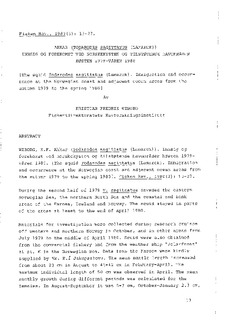Akkar (Todarodes sagittatus (Lamarc)) Innsig og forekomst ved norskekysten og tilstøtende havområder høsten 1979 - våren 1980
Research report
Permanent lenke
http://hdl.handle.net/11250/112853Utgivelsesdato
1980Metadata
Vis full innførselSamlinger
- Fisken og havet (1958- ) [700]
Sammendrag
During the second half of 1979 T. sagittatus invaded the eastern
Norwegian Sea, the northern North Sea and the coastal and bank
areas of the Faroes, Iceland and Norway. The squid stayed in parts
of the areas at least to the end of April 1980.
Materials for investigation were collected during research cruises
off western and northern Norway in October, and in other areas from
July 1979 to the middle of April 1980. Squid were also obtained
from the commercial fishery and from the weather ship "Polarfront"
at st. M in the Norwegian Sea. Data from the Faroes were kindly
supplied by Mr. H.i Jakupsstovu. The mean mantle length increased
from about 23 cm in August to 41-42 cm in February-April. The
maximum individual length of 50 cm was observed in April. The mean
monthly growth during different periods was calculated for the
females. In August-September it was 5-7 cm, October-January 2,3 cm,
January-February 1,5 cm, August-February 3,0 cm. Males were on
average 2-3 cm shorter in mantle length than the females. In northern
Norway the average mantle length was somewhat larger in October-
November 1978 and 1979 than at the same time in 1977 and 1972. The
mean total weight increased from about 280 g in August to 420-540 g
in September and further to 1300 g in February. A female with
mantle length of 50 cm and weighing 3130 g was taken in April.
The length-weight curve was calculated from the relationship W=aLb .
a=0.02, b-3.01.
The liver weight varied considerably, both individually and between
samples, but the mean weight was mostly below 10% of the total
weight, except off northern Norway,
Males were few, constituting 4-11% of the samples along the Norwegian
coast and in the Norwegian Sea, but about 26% near the Hebrides
in November. Nearly all were immature, but a few with developing
gonads, weight 10-20 g, were found in January-February. Males, even
small ones, are easily recognized in the catches by the poor quality
of the skin which deteriorates and becomes chapped shortly after
the catch.
Food items in stomach contents were similar to those identified in
earlier years. Fish dominated, herring, sprat, redfish, blue whiting
and pearlside being most abundant. Squid ranged second, in Norwegian
waters T. sagittatus, in the Norwegian Sea Gonatus -fabricii,
and at the Hebrides, octopods. Various other organisms were identified,
e.g. krill, deep-sea prawns and other shrimps, amphipods,
polychaetes and chaetognaths.
Age determinations from statoliths are in progress, but the interpretation
is constantly difficult. It is assumed that the squid
spawns at an age of 1-1 1/2 years.
Observations with underwater TV indicated that the squid is very
voracious, attacking various kinds of bait, including squid, and
remaining on the bait for up to half an hour.
Fishing technique is improving, and marketing for human consumption,
both domestic and for export, is increasing.
Utgiver
HavforskningsinstituttetSerie
Fisken og havet1980-03
